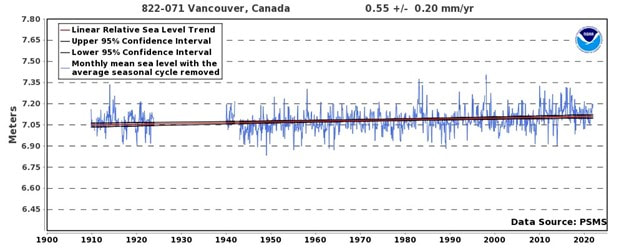|
A recent story in the Vancouver Sun titled Granville Island tenants worried about lack of plan to combat rising sea levels paints a troubled picture of a flooded future for the beloved multi-functional location. The reporter stresses the fragility of the situation stating: Only a bit of decking and some riprap protect 340 businesses, which employ more than 3,000 people. The latest cause for alarm is yet another study of the so-called Doomsday Glacier in Antarctica. That paper, Widespread seawater intrusions beneath the grounded ice of Thwaites Glacier, West Antarctica, discusses the influx of tidal water under the transition zone between the grounded glacier and the floating ice shelf extension. It sets out: The rushing of seawater beneath grounded ice over considerable distances makes the glacier more vulnerable to melting from a warmer ocean than anticipated, which in turn will increase projections of ice mass loss. That said, the study also conversely reports decreasing rates of glacial retreat: 1.0 km/yr from 1992 to 2011 0.6 km/yr from 2011 to 2018 0.5 km/yr from 2018 to 2023 So, even though tidal intrusion is hypothesized to be a factor causing increased melt as oceans warm, the actual grounded ice loss has diminished during (and despite) the most recent “warmest years ever” timeframe. And what degree of doom will impact the planet if the Thwaites ice shelf should collapse? Apparently nothing at all because the floating ice has already displaced the same ocean volume that it will after breaking free or melting, and the grounded glacier is not dependent on the ice shelf for buttressing against slipping into the sea at a faster rate. As the forementioned paper states, the tongue of floating ice offers little to no resistance to flow of the glacier. This is supported by the findings from another 2023 study, Limited Impact of Thwaites Ice Shelf on Future Ice Loss From Antarctica: We conclude that TWIS (Thwaites Ice Shelf) is of limited relevance to upstream flow dynamics in its current configuration, and there appears to be no reason to expect a possible disintegration of the ice shelf to meaningfully impact SLR (Sea Level Rise) projections over the next 50 years. Unaware or unmoved by such comforting scientific determination, David McCann, Creekhouse Building Manager, tells the Sun his business will leave Granville Island at the end of their lease because of flood uncertainty spurred by Intergovernmental Panel on Climate Change warnings and the seawater intrusions study (which was authored by a friend of his). Also interviewed was the Canada Mortgage and Housing Corporation Granville Island Manager, Tom Lancaster, who has worked as an Urban Planner and was on the Advisory Committee for the government’s video series called Adapting to Climate Change on the British Columbia Coast. He states: For the last 15 years, (experts) have been predicting a one-metre rise over the next 100 years, Lancaster said. It’s going to be four or five times (quicker than) that. We’re going to see a lot of flooding over the next 30 years. These assertions are very concerning coming from someone with his background and responsibility. Where does he come up with the reckless contention that sea level rise will take place four or five times (quicker) than the experts have predicted? His disturbing claims are not supported by the Limited Impact study, nor local historical data. In Vancouver relative sea level has been rising slowly at 0.2 mm/yr per the following NOAA graph: The term relative is important because it factors in land subsidence, not just actual ocean volume. Several studies, including Land Subsidence Monitoring in Greater Vancouver Through Synergy of InSAR and Polarimetric Analysis, have confirmed that the weight of local urban development has caused shoreline subsidence. Vancouver sea level measurements take place harbour-side, adjacent to the downtown core. Considering the subsidence from the ever-increasing weight of buildings and infrastructure in our Central Business District, the degree of actual local sea level rise since the early 1900s is negligible or non-existent. The Ausenco Sandwell report to the provincial government, Guidelines for Management of Coastal Flood Hazard Land Use, advised that BC should prepare for a half metre of sea level rise by 2050 and a full metre by 2100. This recommendation was based on information drawn from the Policy Discussion Paper 2010. Their advice now appears to be badly out-of-date given that local relative sea levels have actually decreased since 2010 … … yet that oft-referenced prediction remains undisturbed. Our government’s political agenda does not allow them to alter Climate Change misinformation and the media is more than happy to spread any available bad news, so public anxiety stoked by cherry-picked-disaster-science will no doubt continue to increase unabated.
0 Comments
Leave a Reply. |
Hot Topics
Aboriginal Title Almost Record Heat Atmospheric Rivers Attribution Simulation Carbon Capture Child Litigation Climate Shift Index CO2 Offset Leakage Coastal Flood Risk Democracy Lost Drought Exaggeration Eco-Negativity Eco-Politics ESC Investment Evolution Excess Hydro Expert Hypocrisy Extreme Heatwaves Fake Hype Geo-Engineering Government Bias Heat Waves Hottest Month Ever Hottest Year Ever Housing Crisis Hyperthermia Ice Roads Indigenous Conservation Indoctrination Kelp Farms Landslides Media Bias Mental Illness Misplaced Reconcilliation Misleading Data National Discord Natural Gas Net-Zero Future Outside Play Park Take-Over Political Deception Public Safety Impasse Sea Level Ruse Socialist Agenda Solar Panels Species Not At Risk Statistical Dishonesty Sue Big Oil Temperature Trickery Treaty Infringment Tsunami Refuge Unmarked Burials Unprecedented Drought Urban Heat Island Very Hot Days Warming Causes Cold Water Supply White Dislike Wildfire Wildlife Death Woke Plans Worsening Storms |


